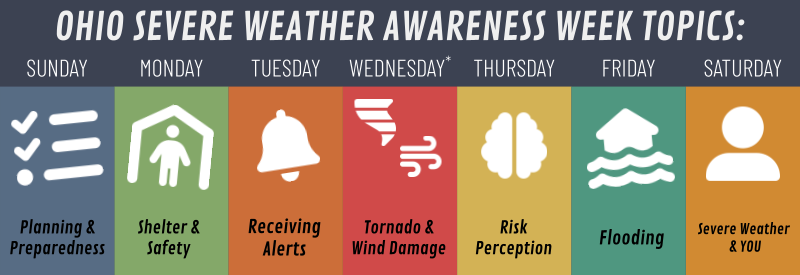Severe Weather Awareness Week: Day 5 Focus On Flood Safety

Table of Contents
Understanding Flood Risks
Identifying Flood-Prone Areas
Determining if your home or workplace is located in a high-risk flood zone is the first step towards effective flood safety. Utilize resources like FEMA flood maps (fema.gov) and your local emergency management website. These resources provide valuable information about flood risk levels in your specific area. Understanding your risk allows for proactive measures.
- Check your property's flood history: Look for evidence of previous flood damage, such as water stains or sediment lines on walls.
- Consider elevation and proximity to waterways: Properties located in low-lying areas, near rivers, streams, or coastlines are inherently more vulnerable to flooding.
- Consult local officials: Your city or county may have additional resources or information specific to your neighborhood's flood risk.
Recognizing Flood Warning Signs
Learning to recognize the early warning signs of impending floods is crucial for timely response. Rapidly rising water levels are a major indicator.
- Pay attention to weather alerts and warnings: Sign up for emergency alerts via your local authorities or through weather apps on your phone.
- Monitor local news and weather reports closely: Stay updated on weather forecasts and potential flood threats in your area.
- Be aware of changes in water levels around your property: Observe any unusual water accumulation or rapid increases in water levels in nearby rivers, streams, or drainage systems. This can often be an early indicator of impending flooding.
Creating a Flood Safety Plan
A comprehensive flood safety plan is essential for mitigating risks and ensuring a safe evacuation.
Developing an Evacuation Plan
Planning escape routes is critical to ensure a swift and safe evacuation.
- Designate a meeting point outside your home: Choose a readily identifiable location where family members can reunite after evacuation.
- Identify several evacuation routes: Having multiple routes helps ensure flexibility in case one route is blocked.
- Prepare an emergency supply kit (discussed below): Having your kit prepared will make evacuation faster and easier.
- Share your plan with family and neighbors: Familiarity with the plan can save crucial time in an emergency.
Building an Emergency Kit
A well-stocked emergency kit is vital for survival during and after a flood.
- Water: Store at least one gallon of water per person per day for several days.
- Food: Include non-perishable food items that require minimal preparation.
- Medications: Pack sufficient medication for several days.
- First-aid supplies: Include bandages, antiseptic wipes, pain relievers, etc.
- Flashlights and batteries: Essential for navigating dark and flooded areas.
- Important documents: Keep copies of insurance policies, IDs, and other crucial documents in a waterproof container.
- Extra clothing and blankets: Provide warmth and protection from the elements.
- Pet supplies: Include food, water, and any necessary medications for your pets.
Protecting Your Property
Taking proactive steps to protect your property can minimize flood damage.
- Move valuable items to upper floors: Elevate furniture, appliances, and other valuable items to prevent damage.
- Seal basement windows and doors: Prevent water intrusion by sealing any cracks or gaps.
- Install sump pumps: Sump pumps can help remove excess water from basements.
- Consider flood barriers: Install flood barriers to prevent water from entering your home.
Responding to a Flood
Knowing how to respond to a flood is crucial for minimizing risks.
Evacuating Safely
If authorities issue an evacuation order, heed their instructions immediately.
- Never drive through flooded areas: Floodwaters can be deeper and faster than they appear, and roads may be compromised. "Turn around, don't drown" is a critical guideline.
- Seek higher ground if possible: Move to an elevated area away from floodwaters.
- Follow designated evacuation routes: Stay on designated routes to avoid hazardous conditions.
Staying Safe During a Flood
If evacuation isn't possible, take steps to ensure your safety.
- Move to the highest level of your home: This minimizes your risk of being trapped by rising floodwaters.
- Avoid contact with floodwater: Floodwater is often contaminated and can carry dangerous bacteria and pathogens.
- Turn off utilities (gas, electricity): This prevents electrical hazards and gas leaks.
- Stay informed about the flood situation: Monitor weather updates and follow instructions from authorities.
Post-Flood Actions
Returning home after a flood requires caution and careful planning.
- Report damage to your insurance company: File a claim as soon as possible to initiate the insurance process.
- Seek professional help for cleanup and repairs: Flood damage can be extensive and may require specialized expertise.
- Be aware of potential hazards: Downed power lines, contaminated water, and structural damage are all potential risks.
Conclusion
This Severe Weather Awareness Week, prioritizing flood safety is crucial. By understanding flood risks, creating a comprehensive flood safety plan, and knowing how to respond to a flood, you can significantly reduce the risk to yourself and your community. Remember, preparation is key to staying safe during severe weather events. Take action today to improve your flood safety preparedness. Don't wait for a disaster to strike; take control of your flood safety now! Invest in your flood safety today for a safer tomorrow.

Featured Posts
-
 Todays Must See Tv And Streaming The Skinny Jab Revolution Black 47 And Roosters
May 25, 2025
Todays Must See Tv And Streaming The Skinny Jab Revolution Black 47 And Roosters
May 25, 2025 -
 Prognozi Konchiti Vurst Schodo Peremozhtsiv Yevrobachennya 2025
May 25, 2025
Prognozi Konchiti Vurst Schodo Peremozhtsiv Yevrobachennya 2025
May 25, 2025 -
 George L Russell Jr Maryland Legal Giant And Progressive Icon Passes Away
May 25, 2025
George L Russell Jr Maryland Legal Giant And Progressive Icon Passes Away
May 25, 2025 -
 Naomi Campbell And Anna Wintour Met Gala 2025 Ban Rumors Explode
May 25, 2025
Naomi Campbell And Anna Wintour Met Gala 2025 Ban Rumors Explode
May 25, 2025 -
 Demna Gvasalia The Future Of Guccis Brand Identity
May 25, 2025
Demna Gvasalia The Future Of Guccis Brand Identity
May 25, 2025
